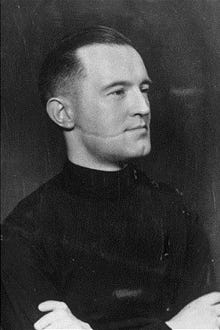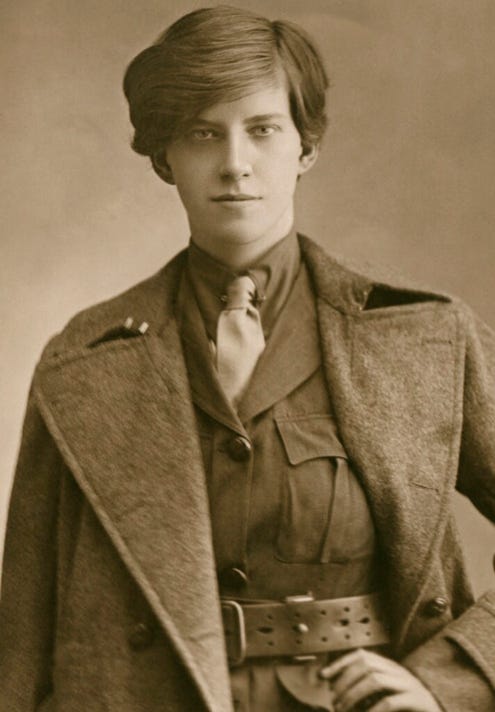The First Fascists
How the British Far Right of the 1920s Offers a Warning for the Present Today
Fascism came to Britain in a very British way - via notices in a newspaper.
In May 1923, a series of adverts appeared in the The Patriot, calling on readers to join an exciting new movement. Inspired by Benito Mussolini – who had seized control of war-flogged Italy the prior year – this movement would fight against communism, national decline and the creeping decadence of the jazz age. This movement would restore Britain to the glory days it had enjoyed before the First World War unleashed its storms of human suffering, and the Bolshevik Revolution stirred dangerously radical thoughts in the minds of fed-up workers and demobilised soldiers. This movement of national saviours would be called the “British Fascisti” (BF).
Incorporated in the summer of 1923 with an alleged membership of 5,000, the BF established itself at 71 Elm Park Gardens, a 4-storey semi-detached townhouse in Chelsea. From this headquarters, a branding operation was swiftly launched to give presence and voice to the new movement. Having altered the name by swapping out “fascisti” for “fascist” - the Italian word was deemed too foreign - the BF started printing a magazine called the British Lion, in which they railed against striking workers and lied about the size of their membership. The BF held recruitment drives at which flags bearing its distinctive symbol of an “F” inlaid on a Yorkshire rose, surrounded by a pledge to defend “King and Country” were displayed. Its members paraded in Hyde Park and Trafalgar Square in their thousands. Aping Mussolini’s squadrismo (action squads), the youth wing wore blue (sometimes black) shirts, black berets and black trousers. The BF elders put on their Sunday best to harangue crowds of on-lookers, warning them of how the foreign contagion of communism was spreading through Britain like a fatal disease.
Reflecting on the BF’s creation from a century’s distance, it’s striking how similar its idiosyncratic composition and range of motivations were to the British far right of today.
For years now, public and parliamentary questions have been asked about the membership and mission of Britain’s contemporary far right. Although it is anchored by celebrity agitators like Stephen Yaxley-Lennon (AKA Tommy Robinson), the movement is nebulous in its form and ever-evolving in its purpose. It is comprised of grassroots anti-immigration groups, racist thugs, haters of globalisation, neo-fascists and occupiers of dubious online spaces. The latter group, according to MI5’s Director-General Ken McCallum, are plugged into a wider network of ‘right-wing extremist influencers, operating globally’ with the aim to ‘fuel grievances and amplify conspiracy theories’. Britain’s far right may be a node in this international network, but it is principally fuelled by a diverse range of national concerns – support for Brexit, outrage at small boats in the Channel, hatred of “woke” football celebrities and liberal London elites, support for the monarchy and a yearning for the good old days are but a few of these drivers. Britain’s contemporary far right is no monolithic entity.
The same was true of the BF of the 1920s which, though inspired by the militarist Italian fascists in their black-shirted uniforms, had an peculiarly muddled British flavour all of its own.
The differences started at the top. Mussolini believed that Italy’s renewal required the destruction of political norms and the installation of a new revolutionary government with himself at its head, chest out and fists flailing. Like Mussolini, the BF’s founder - Rotha Lintorn-Orman - served in the First World War and returned home in despair at the state of her country. Here the similarities ended.
A twenty-six-year-old woman from a well-to-do conservative family, Lintorn-Orman spent the war driving ambulances and training nurses in the Balkans. Having been decorated for her service, she returned from Europe to a comfortable home in Cornwall, with a garden she lovingly tended to. These pleasant surrounds were not enough, however, to distract her from the rolling news of Britain’s economic woes, its seemingly ineffectual government and its restive workforce, which had spent much of 1919 striking, rioting and calling for revolution. And so, using a loan of £50,000 (about £2,000,000 in today’s money) from her mother, Lintorn-Orman decided to follow the lead of Mussolini who, to her mind, was doing a jolly good job of sorting out the shambles of postwar Italy.
Unlike Il Duce, however, Lintorn-Orman wasn’t interested in power. She had no ambition to turn the BF into a political party. She wasn’t looking to run for Prime Minister, let alone march on Westminster and proclaim herself dictator. Instead, Lintorn-Orman wanted to use the new doctrine of fascism to curtail the spread of communism in Britain and strengthen the hand of women in the post-war world. No fan of gender norms, she recruited legions of young females into the BF and had them parade alongside the men in quasi-paramilitary uniforms. She even took a page from the Suffragettes’ book, enlisting BF women in jiu-jitsu classes (how else could they defend themselves from attacks by violent communists?) When not combining fascism with feminism, Lintorn-Orman assured government officials that the BF’s purpose was not to usurp the powers that be as Mussolini had, but to ‘combat socialism and Bolshevism and to defend the British Constitution and Empire’. Her progressive gender politics aside, Lintorn-Orman was a off-beat conservative unconvincingly playing the part of revolutionary upstart.
Her followers were just as odd and varied in their grievances. At 71 Elm Park Gardens, revolution-fearing industrialists and moustachioed army officers who looked like they’d marched out of a Rudyard Kipling novel rubbed shoulders with immigrant-hating hoodlums and opportunistic grifters. Like today’s far right, there were also plenty of conspiracy theorists. Chief among them was the popular author Nesta Webster, whose belief that a secret cabal of Jews, socialists and Freemasons had been running the world since the French Revolution impressed many BF members. Among them was an eighteen-year-old bruiser named William Joyce, who would gain notoriety during the Second World War broadcasting Nazi propaganda into Britain in the guise of “Lord Haw Haw”. Fresh from a stint serving with the brutal Black and Tans in Ireland, young Joyce joined the BF hoping to throw hands with communists, republicans and Jews. This led to the future “Lord Haw Haw” getting “razored” from mouth to ear during a fight that broke out at a political speech in 1924.

More concerned with the threat of communism in the 1920s, the Home Office, Special Branch and MI5 were relatively unbothered by either Joyce’s violent antics or Lintorn-Orman’s offer of BF foot soldiers to help police the streets during times of industrial unrest. Derided for her tomboy looks and ways, the BF leader was viewed by the authorities as a harmless ‘crank’. The violence unleashed by the likes of Joyce was typically characterised as ‘mischievous’. At worst, the MI5 chief Vernon Kell was concerned about the ‘disturbances to public order’ that would ensue if the BF continued to crash communist rallies and trade unionist meetings. The fact that the BF had support from certain politicians and landed gentry led the Home Secretary, William Joynson-Hicks, to endorse the opinion that Britain’s first fascists were ‘a very respectable lot’.
The dismissive attitude of the police and security services allowed the ideologically disparate BF to grow through the 1920s until it was consumed and consolidated by Oswald Mosely’s British Union of Fascists in the 1930s. The story of the BF’s chaotic rise and steady mutation into a more organised fascist party with designs to seize control of Britain’s levers of power is a clear warning from history – a warning of how hubris and indifference feed extremism, allowing it to evolve into dangers far greater than were initially imagined.
The content in this post is drawn from research into my next book, The Afterwar: Britain’s Secret Battle Against Communism and Fascism (scheduled for publication in 2026)




